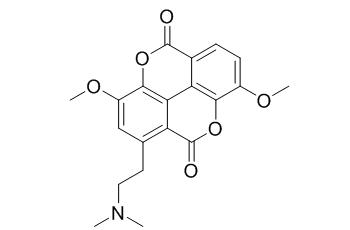Taspine
Taspine shows antitumor activity by modulating the EGFR signaling pathway of Erk1/2 and Akt in vitro and in vivo, it can inhibit growth and induce apoptosis of HUVEC in a dose-dependent manner, it has shown meaningful angiogenesis activity. Taspine exhibits a dose-related cicatrizant effect and an ED50 of 0.375 mg/kg.
Inquire / Order:
manager@chemfaces.com
Technical Inquiries:
service@chemfaces.com
Tel:
+86-27-84237783
Fax:
+86-27-84254680
Address:
1 Building, No. 83, CheCheng Rd., Wuhan Economic and Technological Development Zone, Wuhan, Hubei 430056, PRC
Providing storage is as stated on the product vial and the vial is kept tightly sealed, the product can be stored for up to
24 months(2-8C).
Wherever possible, you should prepare and use solutions on the same day. However, if you need to make up stock solutions in advance, we recommend that you store the solution as aliquots in tightly sealed vials at -20C. Generally, these will be useable for up to two weeks. Before use, and prior to opening the vial we recommend that you allow your product to equilibrate to room temperature for at least 1 hour.
Need more advice on solubility, usage and handling? Please email to: service@chemfaces.com
The packaging of the product may have turned upside down during transportation, resulting in the natural compounds adhering to the neck or cap of the vial. take the vial out of its packaging and gently shake to let the compounds fall to the bottom of the vial. for liquid products, centrifuge at 200-500 RPM to gather the liquid at the bottom of the vial. try to avoid loss or contamination during handling.
Sci Rep.2016, 6:25094
Molecules.2024, 29(22):5261.
J Med Food.2016, 19(12):1155-1165
Int J Mol Sci.2020, 21(9):3239.
Proc. Sci. Math.2024, V25:108-123
Appl. Sci.2021, 11(19),9343.
Phytomedicine.2022, 100:154085.
Biochem Biophys Rep.2024, 40:101830.
Chemistry of Plant Raw Materials2019, 4:135-147
Int J Mol Sci.2021, 22(19):10405.
Related and Featured Products
Planta Med. 1989 Apr;55(2):140-3.
Taspine is the cicatrizant principle in Sangre de Grado extracted from Croton lechleri.[Pubmed:
2748730]
Sangre de Grado extract used by Peruvian natives as a cicatrizant agent, was collected from trees of the species Croton lechleri growing in the Peruvian jungle.
METHODS AND RESULTS:
The Sangre de Grado was found to contain one alkaloid identified as Taspine and which was shown to be the active cicatrizant principle by an in vivo test in mice. This alkaloid exhibited a dose-related cicatrizant effect and an ED50 of 0.375 mg/kg. Experiments with Taspine hydrochloride in order to study its mechanism of action in cell culture systems showed that the alkaloid was non-toxic to human foreskin fibroblasts at concentrations below 150 ng/ml and that it had no effect on cell proliferation. On the other hand, Taspine hydrochloride was found to increase the migration of human foreskin fibroblasts. This effect on the migration of fibroblasts is probably the mechanism by which Sangre de Grado and Taspine hydrochloride accelerate the wound healing process.
CONCLUSIONS:
Using the two-stage mouse skin carcinogenesis system, we have been able to show that neither Sangre de Grado nor Taspine hydrochloride had carcinogenic or tumour promoter activity after 17 months of treatment.
Planta Med. 2011 Nov;77(16):1774-81.
Antitumor activity of taspine by modulating the EGFR signaling pathway of Erk1/2 and Akt in vitro and in vivo.[Pubmed:
21614750 ]
EGFR, as a critical signaling pathway in many human tumors, has become an important target of cancer drug design. Taspine has shown meaningful angiogenesis activity in previous studies. This paper is to investigate the antitumor action of Taspine by modulating the EGFR signaling pathway.
METHODS AND RESULTS:
The study determined the expression of key signaling molecules of EGFR (EGFR, Akt, p-Akt, Erk, and p-Erk) by Western blot and real-time PCR and analyzed their correlations with subsequent reactions. In addition, the cell proliferation, migration, and EGF production were examined by MTT, transwell system, and ELISA. The antitumor activity in vivo was carried out by xenograft in athymic mice. The results showed that Taspine could inhibit A431 and Hek293/EGFR cell proliferation and A431 cell migration as well as EGF production. Compared to the negative control, EGFR, Akt, and phosphorylation of Akt were significantly inhibited by Taspine treatment in A431 and HEK293/EGFR cells. Consistent with the inhibition of Akt activity, Erk1/2 and its phosphorylation were reduced. Moreover, Taspine inhibited A431 xenograft tumor growth.
CONCLUSIONS:
These results suggest that EGFR activated by EGF and its downstream signaling pathways proteins could be downregulated by Taspine in a dose-dependent manner. The antitumor mechanism of Taspine through the EGFR pathway lies in the ability to inhibit A431 cell proliferation and migration by reducing EGF secretion. This occurs through the repression of EGFR which mediates not only MAPK (Erk1/2) but also Akt signals.
Phytomedicine. 2008 Jan;15(1-2):112-9.
Taspine isolated from Radix et Rhizoma Leonticis inhibits growth of human umbilical vein endothelial cell (HUVEC) by inducing its apoptosis.[Pubmed:
17976967]
METHODS AND RESULTS:
The present study was to evaluate the effects of Taspine isolated from Radix et Rhizoma Leonticsi on the growth and apoptosis of human umbilical vein endothelial cell (HUVEC) line by MTT and flow cytometer, respectively.
At the same time, a series of changes were observed in HUVEC treated by Taspine, including microstructure, protein expression of bax, bcl-2 and VEGF. The change of microstructure was observed by transmission electron microscope (TEM). The protein expression of bax and bcl-2 was detected by immunohistochemistry (IHC), and VEGF protein secreted was determined by enzyme-linked immunosorbent assay (ELISA). The results showed Taspine could inhibit growth and induce apoptosis of HUVEC in a dose-dependent manner. Cell cycle was significantly stopped at the S phase. Under electronic microscope, the morphology of HUVEC treated with Taspine showed nuclear karyopycnosis, chromatin agglutination and typical apoptotic body. Bcl-2 and VEGF expressions were decreased and bax expression was increased.
CONCLUSIONS:
All these results demonstrate that Taspine has an inhibitory effect on growth of HUVEC and can induce its apoptosis.



